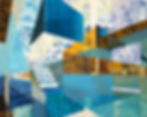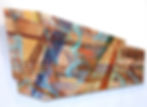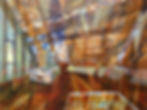Ben Boothby
- Kate Anker
- Oct 27, 2022
- 4 min read
Updated: Nov 29, 2022
Ben works in acrylics and oils on panel. He has been at RWS since August 2021.


For the past fifteen years Ben has been trying to paint what memories look like. There are about a dozen of these paintings in varying sizes on the walls of his studio. These dream-like memoryscapes have architectural bodies that juxtapose with abstract ideas of space where he’s working from memory. He stares at a large painting at the other end of the room, waiting for it to explain itself. “I'm trying to push the illusions and depth of space and still create something that people are interacting with and getting lost in, a world that’s subjective. The associations the viewer is making with color, mood and energy and a specific architectural detail allows them to go to their own store of spatial memory to find a place to stand in.” These works are notably different from the photorealistic paintings he was making after he graduated with his BFA. It was in graduate school that he discovered the power of abstract painting. Ben explains that many painters have fetish-like relationship with paint because they are looking to understand the medium. Creating photorealistic paintings was a way to learn how to use the paint, which is what has allowed him to venture into abstraction. Ben has always been nostalgia-wired, always looking backwards. He got the idea that his graduate thesis would be these perfect reconstructions of photographic memories. “Dredging up a very clear image from memory and being able to paint it--I felt that would be the pinnacle of craft in painting, to be able to translate verbatim the vision of the mind.” They were not very good paintings, he says; very autobiographical and not very interesting to other people. "The paintings didn’t speak to something larger than themselves." Painting is a powerful form of communication for Ben. “Once you get a little taste of what’s possible, communicating without words, you start seeing more of it. You start finding other ways to initiate that communication,” ways that resonate with other human beings. Abstraction became an important aspect of his communication with the viewer. When he was developing his thesis and researching memory and the brain’s chemistry he learned that spatial memory occupies the largest space in our memory, unbeknownst to us. “It’s a really strong entry point for the painter to engage with the viewer. Spatial memory is how we know where we just put our coffee cup down, and how we know how to walk around our house in the dark. It’s a survival tool that makes us human; to store that information subconsciously rather than wasting brain activity constantly scanning the world to see where things are in relation to each other.” Memories are an autobiographical construction that we think of factual and as outside ourselves, but it’s an internalized fiction of our experience in the world. “I wanted my paintings to have this kind of process where I was constructing and building up a thing that would become a contradictory puzzle of space so that it mimics the process that we do in our own minds, especially for memories of familiar places that are in the distant past like a childhood bedroom.” We’ve rewritten over that memory so many times that it becomes an amalgam of fiction. Masking tape is essential to his painting process. He paints with tape in that part of how he thinks about its construction is by covering what he likes so that the next layer of paint doesn’t cover it up. “Masking out what you want is a negative-space working backwards so you can work on the areas that need work.” Ben recently realized that this is a process-based form of art. “How I get here is as important as the result.” Ben paints without a clear idea of what the finished painting should look like. He stops when it gets to a place where everything is in balance and there are enough visual surprises. “It’s an open-ended intuitive painting process. I don’t know when it will be done. It just kind of gets there eventually and sometimes I have to push it past it’s tipping point to ruin it in order to know how to get back around to that.” Ben resonates with the work when he’s open to the process. He enjoys being surprised by moments with the paint where something amazing happens and it feels effortless. As an artist, it is his job to cultivate that space where these moments can happen, and to enter his studio practice with the right frame of mind. “The right intentions and…there are so many variables that go into a brushstroke, like color value, viscosity of the paint, the brush chosen, my muscle movements, the connection between my mind and those muscle movements. There are so many variables that need to be synced up in the paint for that to happen, that surprises me and feels like the best possible resolution for that passage in the painting.” Those are the moments that keep propelling Ben’s desire to paint, the moments where you wonder where 'it' comes from. Contact Ben through his website, benboothby.com or via email, ben.boothby@gmail.com.





